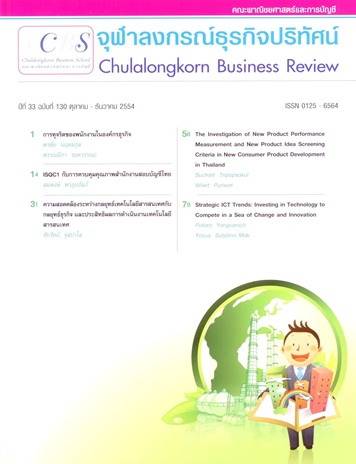Strategic ICT Trends: Investing in Technology to Compete in a Sea of Change and Innovation
Keywords:
ICT market trends, cloud computing, innovation, business intelligence, consumerization of IT, GUI, NUI, social networkingAbstract
บทคัดย่อ
เทคโนโลยีสารสนเทศและการสื่อสารมีการเปลี่ยนแปลงอย่างต่อเนื่อง โดยมีแรงผลักดันทางการตลาดหลายด้านที่กดดันให้องค์กรต่างๆ พยายามสร้างนวัตกรรมใหม่ขึ้นมา เพื่อตอบสนองความต้องการของผู้บริโภคและเก็บเกี่ยวผลประโยชน์ที่ได้รับจากโอกาสทางการตลาดใหม่ๆ ในบทความนี้กล่าวถึงแนวโน้มไอซีที 6 ประการที่อาจนำมาซึ่งการเปลี่ยนแปลงการลงทุนในเทคโนโลยีขององค์กร ได้แก่ 1) คลาวด์คอมพิวติ้ง (Cloud Computing) ซึ่งทำให้เกิดการเปลี่ยนแปลงในต้นทุนรวมของการลงทุนในสาธารณูปโภคด้านไอซีที โดยเฉพาะอย่างยิ่งการเพิ่มขีดความสามารถการทำงานในรูปแบบต่างๆ เช่น การเติบโตอย่างรวดเร็ว ฤดูกาล และการเกิดความต้องการที่ไม่ได้คาดหมาย เป็นต้น 2) นวัตกรรมเพื่อการเติบโต (Innovation for Growth) เป็นแรงผลักดันทางธุรกิจที่มีอำนาจสูง ซึ่งองค์กรต้องสามารถแยกความแตกต่างได้ว่า นวัตกรรมไอซีทีชนิดใดสามารถทำให้องค์กรก้าวขึ้นเป็นผู้นำในอุตสาหกรรมได้ 3) ธุรกิจอัจฉริยะ (Business Intelligence) เป็นแรงผลักดันที่ช่วยให้เกิดการผสมผสานข้อมูลต่างๆ ในองค์กรให้เกิดความจริงที่เป็นหนึ่งเดียว ซึ่งจะสามารถทำให้เกิดการเปลี่ยนแปลงอย่างสำคัญในกลยุทธ์องค์กรและการวางตำแหน่งผลิตภัณฑ์ 4) การบริโภคเทคโนโลยีไอที (Consumerization of IT) ทำให้เกิดการคาดหวังในแผนกไอทีที่สูงขึ้น และขยายความต้องการในโครงสร้างพื้นฐานและเครื่องมือต่างๆ ในการวางกลยุทธ์ 5) การมีปฏิสัมพันธ์อย่างเป็นธรรมชาติ (Natural User Interfaces) คือ การเปลี่ยนแปลงในเรื่องปฏิสัมพันธ์ระหว่างผู้บริโภคและเทคโนโลยี และมีการขยายวงกว้างขึ้น อันเกิดจากความก้าวหน้าของนวัตกรรม สุดท้ายคือ 6) การบริการผ่านเครือข่ายทางสังคม (Social Network Service) ซึ่งทำให้เกิดกระแสของการปรับเปลี่ยนการมีปฏิสัมพันธ์ทั้งในสังคมและผู้เชี่ยวชาญ รวมทั้งความสามารถของนักโฆษณาและผู้จัดหางานในการสื่อสารกับผู้บริโภคอีกหลายล้านคน
คำสำคัญ : แนวโน้มตลาดไอซีทีคลาวด์คอมพิวติ้ง นวัตกรรม ธุรกิจอัจฉริยะ การบริโภคเทคโนโลยีไอที การมีปฏิสัมพันธ์อย่างเป็นธรรมชาติ เครือข่ายทางสังคม
Abstract
Information and communication technologies are constantly changing. Key market drivers have forced companies to be at the cutting edge of innovation to meet customer demands and take advantage of new market opportunities. There are six strategic ICT trends that are changing how companies invest in technology.
Cloud Computing is changing how companies invest in ICT infrastructure dramatically lowering total cost of ownership, especially for a number of optimal workload patterns such as rapid growth, seasonality, on and off, and unpredictable bursting. Innovation for Growth is a powerful business driver and companies must be able to differentiate what type of ICT innovation will help establish themselves as industry leaders. Business Intelligence is driving the consolidation of corporate data into a “single version of the truth” enabling major changes in corporate strategy and product positioning. The Consumerization of IT has dramatically raised the expectations placed upon corporate IT departments and expanded the need for platform and device agnostic strategies. Natural User Interfaces are altering how people interface with technology and expanding access to the masses through new and innovative solutions. Finally, Social Network Services has taken the world by storm transforming both social and professional interactions as well as the ability for advertisers/recruiters to directly target hundreds of millions of customers.
Keywords : ICT market trends, cloud computing, innovation, business intelligence, consumerization ofIT, GUI, NUI, social networking
Downloads
How to Cite
Issue
Section
License
Opinions and discussions in papers published by the Creative Business and Sustainability Journal (CBSJ) are deemed as personal opinions and the responsibility of the writers. They are not the opinions or responsibility of the Chulalongkorn Business School of Chulalongkorn University.
Papers, content, information etc. appearing in the Journal are deemed to be the copyright property of the Chulalongkorn Business School of Chulalongkorn University. Anybody or any organization that wishes to publish any part of them or use them in any way must obtain written permission from the Chulalongkorn Business School, Chulalongkorn University.


